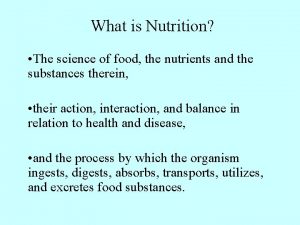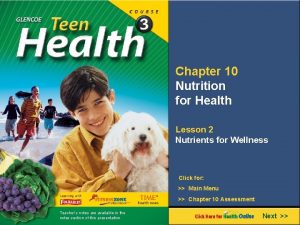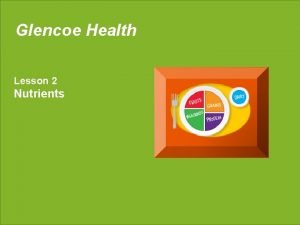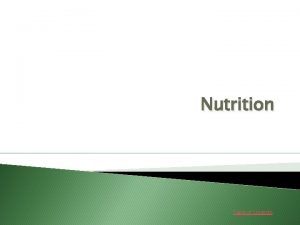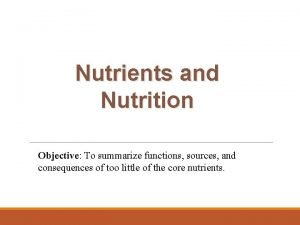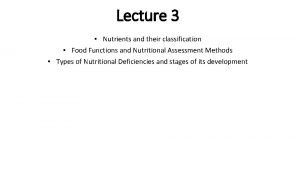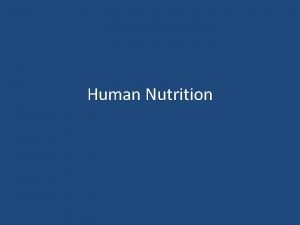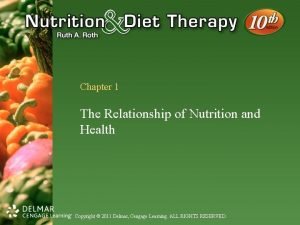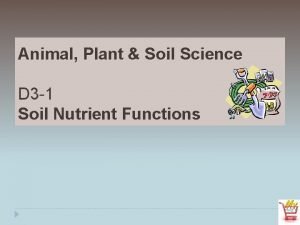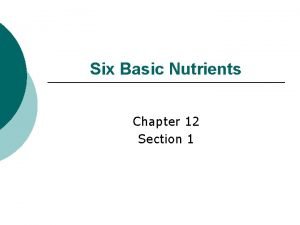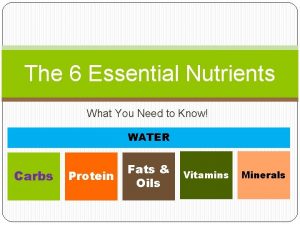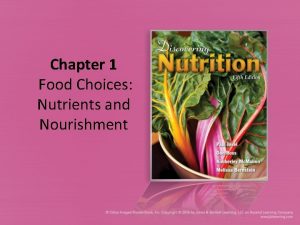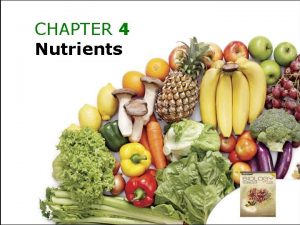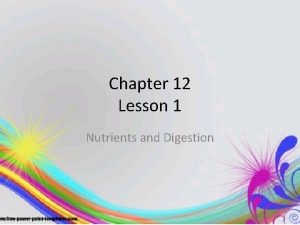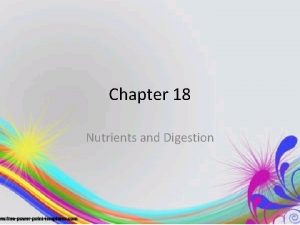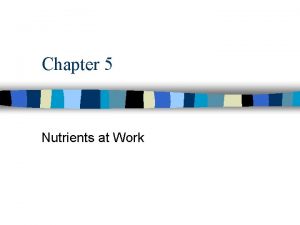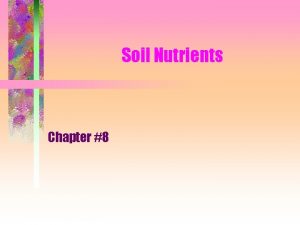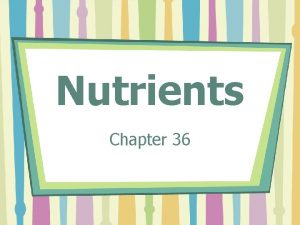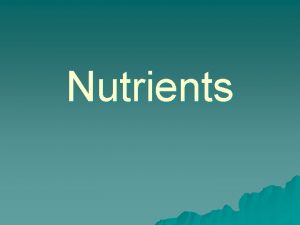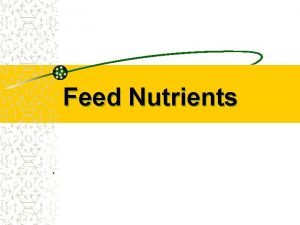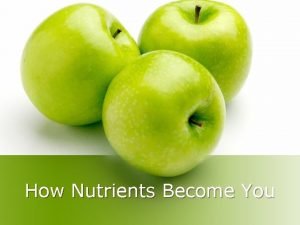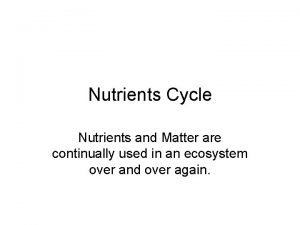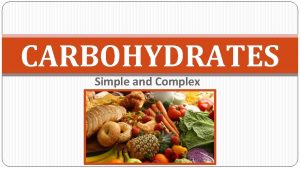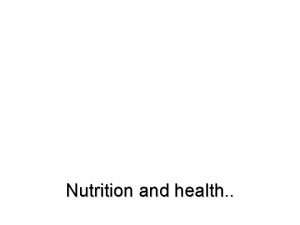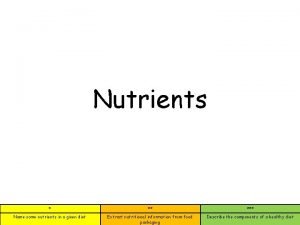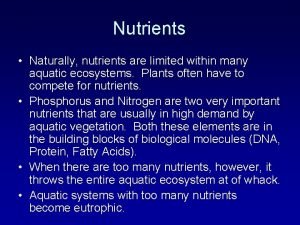Chapter 1 Nutrients and Nourishment The Science of





































- Slides: 37

Chapter 1 Nutrients and Nourishment

The Science of Nutrition • Identifies amount of food we need • Recommends best food sources • Identifies components in food that are helpful or harmful • Helps us make better choices • Improves our health • Reduces our risk of disease • Increases our longevity

Why Do We Eat the Way We Do? © Monkey Business Images/Shutter. Stock, Inc. • Personal preferences • Enjoyment • Nourishment • Age Figure 1. 1 Adventures in eating. Babies and toddlers are willing to try new things, generally after repeated exposure.

Why Do We Eat the Way We Do? • Sensory influences • Flavor • Describes both taste and smell • Texture also plays a part • Classic tastes: Sweet, sour, bitter, salty, and umami

• Social, emotional, and cognitive influences • Habits • Comfort/Discomfort Foods • Advertising and Promotion • Eating Away from Home • Food and Diet Trends • Social Factors • Knowledge of Health Figure 1. 3 Comfort foods. and Nutrition © Alena Ozerova/ Shutterstock, Inc. Why Do We Eat the Way We Do?

Why Do We Eat the Way We Do? • Environmental influences • Economics • Lifestyle • Availability • Cultural Influences • Religion

Figure 1. 8 A social-ecological framework for nutrition and physical activity decisions. Modified from: Centers for Disease Control and Prevention. <Insert Figure 1 -8>

The American Diet • How healthful is the “American” diet? • Too few nutrient-dense foods • Fruits, vegetables, low-fat dairy, and whole-grain foods • Too much of the foods known to be harmful • Sodium, solid fat, saturated fat, and sugar

Table 1. 1 Average U. S. Consumption Compared to Recommendations, 2013 Reproduced from U. S. Department of Agriculture and U. S. Department of Health and Human Services. Dietary Guidelines for Americans, 2010. 7 th ed. Washington, DC: U. S. Government Printing Office; December 2010. <Insert Table 1. 1>

Introducing the Nutrients • Functions • Normal growth and development • Maintaining cells and tissues • Fuel to do physical and metabolic work • Regulating body processes

Introducing the Nutrients • Six classes of nutrients • Carbohydrates • Lipids (fats and oils) • Proteins • Vitamins • Minerals • Water

Figure 1. 9 The six classes of nutrients.

Introducing the Nutrients • Definition of nutrients • Absence from the diet results in a specific change in health • Putting the chemical back in the diet will reverse the change in health • Not only chemicals in food • Phytochemicals • Antioxidants

Figure 1. 10 Nutrients have three general functions in your body.

Introducing the Nutrients • Classifications of nutrients • Macronutrients • Carbohydrates, lipids, and proteins • Micronutrients • Vitamins and minerals • Organic (contain carbon) • Carbohydrates, lipids, proteins, and vitamins • Inorganic • Minerals and water

Introducing the Nutrients • Carbohydrates • Sugars and starches • Functions • Energy source • Food sources • Grains • Vegetables • Legumes • Fruits • Dairy products

Introducing the Nutrients • Lipids • Triglycerides (fats and oils), cholesterol, and phospholipids • Functions • Energy source, structure, regulation • Food sources • Fats and oils • Meats • Dairy products • Some plant sources

Introducing the Nutrients • Proteins • Made of amino acids • Functions • Energy source, structure, regulation • Food sources • Meats • Dairy products • Grains, legumes, vegetables

Introducing the Nutrients • Vitamins • Functions • Regulate body processes • Play a vital role in extracting energy • Fat-soluble • A, D, E, K • Water-soluble • B vitamins, vitamin C • Food sources • All food groups

Introducing the Nutrients • Minerals • Macrominerals • Microminerals, or trace minerals • Functions • Structure, regulation • Food sources • All food groups

Introducing the Nutrients • Water • Most important nutrient • Functions • Temperature control • Lubrication of joints • Transportation of nutrients and wastes • Food sources • Beverages • Foods

Introducing the Nutrients • Nutrients and energy • Energy • The capacity to do work • Energy sources • Carbohydrates, lipids, protein • Measure of energy • Kilocalorie • 1, 000 calories = 1 kilocalorie

Figure 1. 11 Energy sources. Carbohydrate, fat, protein, and alcohol provide different amounts of energy per gram.

Introducing the Nutrients • Energy in foods • When is a kilocalorie a calorie? • Kilocalorie = 1, 000 calories • Units used to measure food energy • 1 kcal = Amount of energy it would take to raise the temperature of 1 kg of water by 1 degree Celsius

Introducing the Nutrients • How can we calculate the energy available from foods? • Carbohydrate yields 4 kcal for every gram • Protein yields 4 kcal for every gram • Fat yields 9 kcal per gram • Example 30 g carb × 4 kcal/g = 156 kcalories 10 g protein × 4 kcal/g = 40 kcalories 16 g fat × 9 kcal/g = 144 kcalories TOTAL = 340 kcalories

Introducing the Nutrients • Energy in food • Be food smart: Calculate the percentages of calories in food

Diet and Health • What does it mean to be healthy? • WHO defines health as “a state of complete physical, mental, and social well-being and not merely the absence of disease or infirmity. ”

Diet and Health • Disease is “an impairment of the normal state of the living animal … that interrupts or modifies the performance of the vital functions. ” • Food choices are most likely to affect our risk for developing chronic diseases.

Diet and Health • Physical activity • Sedentary lifestyle • Risk factor for chronic disease • Role in long-term weight management • Recommendations for adults • 150 minutes of moderate-intensity or 75 minutes of vigorous-intensity aerobic activity per week • Muscle-strengthening activities on 2 or more days a week

Table 1. 3 Leading Causes of Death: United States

Applying the Scientific Process to Nutrition • The Scientific Process enables researchers to test the validity of hypotheses • Hypothesis: Proposed explanation made on the basis of limited evidence as a starting point for further investigation • Used to expand our nutrition knowledge

Applying the Scientific Process to Nutrition • Common study designs - Epidemiological studies - Animal and cell culture studies - Case control studies - Clinical trials • Randomized • Double-blind • Placebo-controlled

Steps of the Scientific Process Figure 1. 12 The scientific process.

From Research Study to Headline • Publishing experimental results • Scientists publish results of experiments in scientific journals to communicate new information • Peer review process reduces chance that low -quality research is published

From Research Study to Headline • Sorting facts and fallacies in the media • Popular media may distort facts through omission of details. • In-depth research article becomes 30 -second sound bite.

Figure 1. 14 Sorting facts and fallacies.

Evaluating Information on the Internet • • There are no rules for posting on the Internet. Consider the source. Keep in mind the scientific method. Be on the lookout for “junk science. ”
 Levels of nourishment in a food chain
Levels of nourishment in a food chain Forest food chain
Forest food chain The science of food the nutrients and substances therein
The science of food the nutrients and substances therein One of my favorite subjects
One of my favorite subjects Chapter 10 lesson 2 nutrients
Chapter 10 lesson 2 nutrients Texture repair glencoe
Texture repair glencoe Chapter 5 nutrients at work
Chapter 5 nutrients at work Passageway of water and nutrients
Passageway of water and nutrients Food table of contents
Food table of contents Nutrients and their functions table
Nutrients and their functions table Nutrients and their classification
Nutrients and their classification Nutrients and their functions table
Nutrients and their functions table How is waste and nutrients transported in a cnidarian
How is waste and nutrients transported in a cnidarian Organic and inorganic nutrients
Organic and inorganic nutrients Nutrients and their functions
Nutrients and their functions Masses of cells form and steal nutrients from healthy cells
Masses of cells form and steal nutrients from healthy cells Nutrients and their functions
Nutrients and their functions Six basic nutrients
Six basic nutrients 6 essential nutrients
6 essential nutrients Hát kết hợp bộ gõ cơ thể
Hát kết hợp bộ gõ cơ thể Frameset trong html5
Frameset trong html5 Bổ thể
Bổ thể Tỉ lệ cơ thể trẻ em
Tỉ lệ cơ thể trẻ em Gấu đi như thế nào
Gấu đi như thế nào Tư thế worm breton là gì
Tư thế worm breton là gì Alleluia hat len nguoi oi
Alleluia hat len nguoi oi Các môn thể thao bắt đầu bằng tiếng nhảy
Các môn thể thao bắt đầu bằng tiếng nhảy Thế nào là hệ số cao nhất
Thế nào là hệ số cao nhất Các châu lục và đại dương trên thế giới
Các châu lục và đại dương trên thế giới Công thức tính thế năng
Công thức tính thế năng Trời xanh đây là của chúng ta thể thơ
Trời xanh đây là của chúng ta thể thơ Mật thư tọa độ 5x5
Mật thư tọa độ 5x5 Làm thế nào để 102-1=99
Làm thế nào để 102-1=99 độ dài liên kết
độ dài liên kết Các châu lục và đại dương trên thế giới
Các châu lục và đại dương trên thế giới Thơ thất ngôn tứ tuyệt đường luật
Thơ thất ngôn tứ tuyệt đường luật Quá trình desamine hóa có thể tạo ra
Quá trình desamine hóa có thể tạo ra Một số thể thơ truyền thống
Một số thể thơ truyền thống


